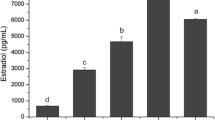Abstract
The selective withdrawal of pituitary gonadotropins through specific antibodies is known to cause disruption of spermatogenesis. The cellular mechanism responsible for the degenerative changes under isolated effect of luteinizing hormone (LH) deprivation is not clear. Using antibodies specific to LH we have investigated the effect of immunoneutralization of LH on apoptotic cell death in the testicular cells of the immature and the adult rats. Specific neutralization of LH resulted in apoptotic cell death of germ cells, both in the immature and the adult rats. The germ cells from control animals showed predominantly high molecular weight DNA, while the antiserum treated group showed DNA cleavage into low molecular weight DNA ladder characteristic of apoptosis. This pattern could be observed within 24 h of a/s administration and the effect could be reversed by testosterone. The germ cells were purified by centrifugal elutriation and the vulnerability of germ cell types to undergo apoptosis under LH deprivation was investigated. The round spermatids and the pachytene spermatocytes were found to be the most sensitive germ cells to lack of LH and underwent apoptosis. Interestingly, spermatogonial cells were found to be the least sensitive germ cells to the lack of LH in terms of apoptotic cell death. Results show that LH, in addition to being involved in the germ cell differentiation, is also involved in cell survival and prevent degeneration of germ cells during spermatogenesis. Apoptotic DNA fragmentation may serve as a useful marker for the study of hormonal regulation of spermatogenesis and the specific neutralization of gonadotropic hormones can be a reliable model for the study of the molecular mechanism of apoptosis.
Similar content being viewed by others
References
Allan, D.J., Harmon, B.V. & Roberts, S.A. (1992).Cell Prolif.,25, 241–250.
Bartke, A. (1995).Endocrinology,136: 3–4.
Billig, H., Furuta, I., Rivier, C, Tapanainen, J., Parvinen, M. & Hsueh, A.J.W. (1995).Endocrinology,136, 5–12.
Boise, L.H., Garcia, M.G., Postema, C.E., Ding, L., Lindsten, T., Turka, L.A., Mao, Z., Nuñez, G. & Thompson, C.B. (1993).Cell 74, 597–608.
Bucci, L.R., Brock, W.A., Johnson, T.S. & Meisrich, M.L. (1986).Biol. Reprod.,34, 195–206.
Buttyan, R., Olsson, C.A., Pintar, J., Chang, C, Bandyk, M., Poying, Ng & Sawczuk, I.S. (1989).Mol. Cell Biol.,9, 3473–3481.
Dighe, R.R. & Moudgal, N.R. (1983).Arch. Biochem. Biophv.,225, 490–499.
Johnson, L., Petty, C. & Neaves, W.B. (1983).Biol. Reprod.,29, 207–215.
Martin, S.J., Green, G.R. & Cotter, T.G. (1994).TIBS,19, 26–30.
Meistrich, M.L., Longtin, J., Brook, W.A., Grimes, S.R. Jr & Mace, M.L. (1981).Biol. Reprod.,25, 1065–1077.
Madhwaraj, H.G. & Moudgal, N.R. (1970).Endocrinology,86, 874.
Miething, A. (1992).Cell Tissue Res.,267: 583–590.
Moudgal, N.R. & Dighe, R.R. (1985).Biosci Reports,5, 943–955.
Moudgal, N.R., Ravindrana’h, N., Murthy, G.S., Dighe, R.R., Aravindan, G.R. & Martin, F. (1992).(Macaco, radiata). J. Reprod. Fertil.,96, 91–102.
Murty, G.S.R.C., Sheela Rani, C.S., Moudgal, N.R. & Prasad, N.R. (1979).J. Reprod. Fertil. suppl.26, 147–163.
Oltvai, Z.N., Milliman, C.L. & Korsmever, S.J. (1993).Cell,74, 609–619.
Raff, M.C. (1992).Nature,356, 397–400.
Sambrook, K. & Fritsch. Maniatis. (1989). Molecular cloning a laboratory manual. 2nd edition. Cold Spring Harbor Press. p. 9.16.
Shetty, J., Marathe, G.K. & Dighe, R.R. (1994).16th International Congress of Biochemistry and Molecular Biology, New Delhi, India. Abstract no. p.9–5: 353.
Shetty, J., Marathe, G.K., Ramaswamy, S. & Dighe, R.R. (1995). Communicated to Endocrine.
Sheela Rani, C.S., Murty. G.S.R.C. & Moudgal, N.R. (1978).Intl. J. Androl.,1, 489–500.
Shivashankar, S., Prasad, M.R.N., Thampan, T.N.R.V., Sheela Rani, C.S. & Moudgal, N.R. (1977).Indian J. Exp. Biol.,15, 845–849.
Suresh, R., Aravindan, G.R. & Moudgal, N.R. (1992).J. Biosci.,17, 413–419.
Tapanainen, J.S., Tilly, J.L., Vihko, K.K. & Hsueh, J.W. (1993).Mol. Endocrinol.,7, 643–650.
Tilly, J.L., Kowalski, K.I., Johnson, A.L. & Hsueh, A.J.W. (1991).Endocrinology,129, 2799–2801.
Troiano, L., Fustini, M.F., Lovato, E., Frasoldati, A., Malorni. W., Capri, M., Grassilli, E., Marama, P. & Franceschi, C. (1994).Biochem. Biophys. Res. Commun.,202, 1315–1321.
Vaishnav, M.Y. & Moudgal, N.R. (1991).Indian J. Biochem. Biophy.,28, 513–520.
Wong, P., Pineault, J., Lakins, J., Taillefer, D., Leger, J., Wang, C. & Tenniswood, M. (1993).J. Biol. Chem.,268, 5021–5031.
Wyllie, A.H. (1993).J. Cancer,67, 205–208.
Zhong, L., Sarafian, T., Kane, D.J., Charles, A.C., Mah, S.P., Edwards, R.H. & Bredesen, D.E. (1993).Proc. Natl. Acad. Sci. USA,90, 4533–4537.
Author information
Authors and Affiliations
Rights and permissions
About this article
Cite this article
Marathe, C.K., Shetty, J. & Dighe, R.R. Selective immunoneutralization of luteinizing hormone results in the apoptotic cell death of pachytene spermatocytes and spermatids in the rat testis. Endocr 3, 705–709 (1995). https://doi.org/10.1007/BF03000201
Received:
Accepted:
Issue Date:
DOI: https://doi.org/10.1007/BF03000201



